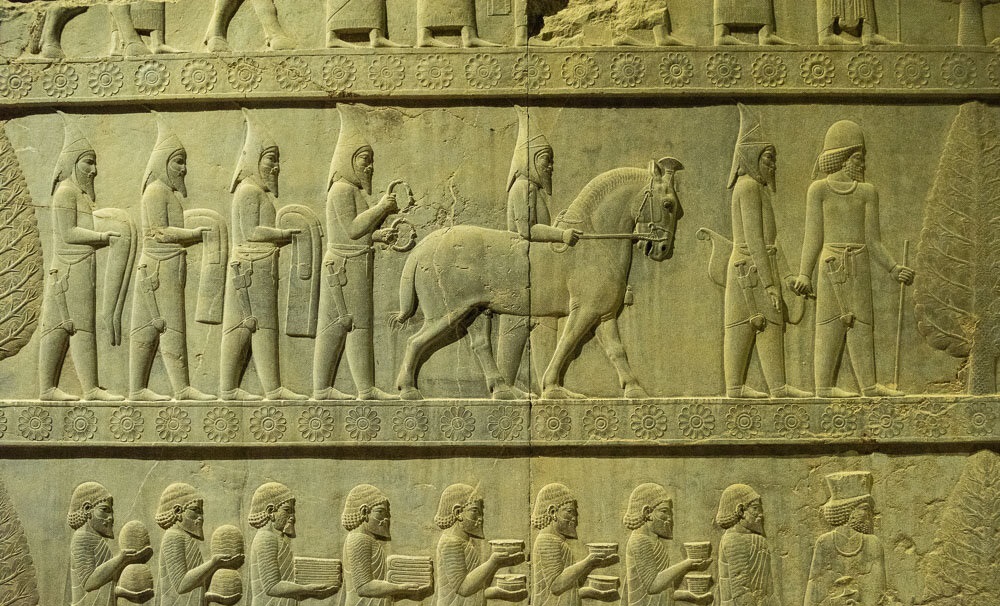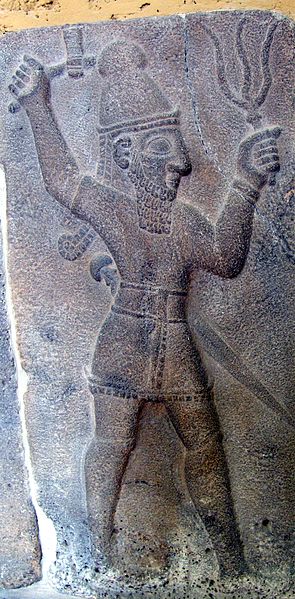|
Tugdamme
Tugdamme or Dugdammi (Akkadian: or ; Ancient Greek: , ; Latin: ) was a Cimmerian king of the mid-seventh century BC. Name Akkadian ( or ) and Ancient Greek () are derived from a name in a Cimmerian dialect of the Old Iranian Scythian language. The linguist János Harmatta reconstructed this original Cimmerian name as , meaning "giving happiness." The Iranologist Ľubomír Novák has noted that the attestation of the name in the forms and in Akkadian and the forms and in Greek shows that its first consonant had experienced the change of the sound /d/ to /l/, which is consistent with the phonetic changes attested in the Scythian languages. The Scythologist Askold Ivantchik has instead suggested that the name / was a loanword from an Anatolian language, more specifically Luwian, while also accepting the alternative possibility of a derivation from a variant of the name of the Hurrian deity / . Historical background In the 8th and 7th centuries BCE, a significant moveme ... [...More Info...] [...Related Items...] OR: [Wikipedia] [Google] [Baidu] |
Sandakšatru
Sandakshatru or Sandakuru ( Akkadian: or ) was the last known Cimmerian king. Name The name of this Cimmerian king is attested in a form which can be read as either or , which are derived from a name in a Cimmerian dialect of the Old Iranian Scythian language. The linguist János Harmatta reconstructed this original Cimmerian name as , meaning "splendid son," while the Scythologist Askold Ivantchik derives the name from a compound term consisting of the name of the Anatolian deity , and of the Iranian term Historical background In the 8th and 7th centuries BC, a significant movement of the nomads of the Eurasian steppe brought the Scythians into Southwest Asia. According to Herodotus, this movement started when the Massagetae or the Issedones migrated westwards, forcing the Scythians to the west across the Araxes and into the Caspian Steppe, from where they displaced the Cimmerians. Under Scythian pressure, the Cimmerians migrated to the south through the , Alagir and ... [...More Info...] [...Related Items...] OR: [Wikipedia] [Google] [Baidu] |
Cimmerians
The Cimmerians (Akkadian: , romanized: ; Hebrew: , romanized: ; Ancient Greek: , romanized: ; Latin: ) were an ancient Eastern Iranian equestrian nomadic people originating in the Caspian steppe, part of whom subsequently migrated into West Asia. Although the Cimmerians were culturally Scythian, they formed an ethnic unit separate from the Scythians proper, to whom the Cimmerians were related and who displaced and replaced the Cimmerians.: "As the Cimmerians cannot be differentiated archeologically from the Scythians, it is possible to speculate about their Iranian origins. In the Neo-Babylonian texts (according to D’yakonov, including at least some of the Assyrian texts in Babylonian dialect) and similar forms designate the Scythians and Central Asian Saka, reflecting the perception among inhabitants of Mesopotamia that Cimmerians and Scythians represented a single cultural and economic group" The Cimmerians themselves left no written records, and most information about t ... [...More Info...] [...Related Items...] OR: [Wikipedia] [Google] [Baidu] |
Teušpa
Teushpa (Akkadian: , and ) was an early 7th-century BC king of the Cimmerians. Name and are Akkadian forms of a name which originates from a Cimmerian dialect of the Old Iranian Scythian language. The linguist János Harmatta reconstructed this original Cimmerian name as , meaning "swelling with strength." Askold Ivantchik instead posits three alternative suggestions for an Old Iranian origin of : * "abductor of horses" * "abductor dog" * "divine dog" Despite the similarity of 's name with that of his Persian contemporary (), they do not seem to be etymologically related. Historical background In the 8th and 7th centuries BCE, a significant movement of the nomads of the Eurasian steppe brought the Scythians into Southwest Asia. According to Herodotus, this movement started when the Massagetae or the Issedones migrated westwards, forcing the Scythians to the west across the Araxes and into the Caspian Steppe, from where they displaced the Cimmerians. Under Scythian press ... [...More Info...] [...Related Items...] OR: [Wikipedia] [Google] [Baidu] |
Volga
The Volga (; russian: Во́лга, a=Ru-Волга.ogg, p=ˈvoɫɡə) is the List of rivers of Europe#Rivers of Europe by length, longest river in Europe. Situated in Russia, it flows through Central Russia to Southern Russia and into the Caspian Sea. The Volga has a length of , and a catchment area of «Река Волга» , Russian State Water Registry which is more than twice the size of Ukraine. It is also Europe's largest river in terms of average discharge (hydrology), discharge at delta – between and – and of drainage basin. It is widely regarded as the Rivers in Russia, national river of Russia. The hypothetical old Russian state, the Rus' Khaganate, arose along the Volga . Historically, the river served as an important meeting place of various Eurasian civilizations. The river flows in Russia through forests, Fo ... [...More Info...] [...Related Items...] OR: [Wikipedia] [Google] [Baidu] |
Issedones
The Issedones (Ἰσσηδόνες) were an ancient people of Central Asia at the end of the trade route leading north-east from Scythia, described in the lost ''Arimaspeia'' of Aristeas, by Herodotus in his ''History'' (IV.16-25) and by Ptolemy in his ''Geography''. Like the Massagetae to the south, the Issedones are described by Herodotus as similar to, yet distinct from, the Scythians. __TOC__ Location The exact location of their territorial span in Central Asia is unknown. The Issedones are "placed by some in Western Siberia and by others in Chinese Turkestan," according to E. D. Phillips. Herodotus, who allegedly got his information through both Greek and Scythian sources, describes them as living east of Scythia and north of the Massagetae, while the geographer Ptolemy (VI.16.7) appears to place the trading stations of ''Issedon Scythica'' and ''Issedon Serica'' in the Tarim Basin. Some speculate that they are the people described in Chinese sources as the ''Wusun''. J.D.P. ... [...More Info...] [...Related Items...] OR: [Wikipedia] [Google] [Baidu] |
Kraków
Kraków (), or Cracow, is the second-largest and one of the oldest cities in Poland. Situated on the Vistula River in Lesser Poland Voivodeship, the city dates back to the seventh century. Kraków was the official capital of Poland until 1596 and has traditionally been one of the leading centres of Polish academic, economic, cultural and artistic life. Cited as one of Europe's most beautiful cities, its Old Town with Wawel Royal Castle was declared a UNESCO World Heritage Site in 1978, one of the first 12 sites granted the status. The city has grown from a Stone Age settlement to Poland's second-most-important city. It began as a hamlet on Wawel Hill and was reported by Ibrahim Ibn Yakoub, a merchant from Cordoba, as a busy trading centre of Central Europe in 985. With the establishment of new universities and cultural venues at the emergence of the Second Polish Republic in 1918 and throughout the 20th century, Kraków reaffirmed its role as a major national academic and a ... [...More Info...] [...Related Items...] OR: [Wikipedia] [Google] [Baidu] |
Massagetae
The Massagetae or Massageteans (Ancient Greek: ; Latin: ), also known as Sakā tigraxaudā (Old Persian: , "wearer of pointed caps") or Orthocorybantians (Ancient Greek: ; Latin: ),: As for the term “Orthocorybantii”, this is a translation of Iranian “wearers of pointed caps”: "The (who wear pointed caps) were known to Greek authors as the , a direct translation of the Old Persian name" were an ancient Eastern Iranian Saka people who inhabited the steppes of Central Asia and were part of the wider Scythian cultures. The Massagetae rose to power in the 8th to 7th centuries BCE, when they kickstarted a series of events with wide-reaching consequences by expelling the Scythians out of Central Asia and into the Caucasian and Pontic Steppes. The Massagetae are most famous for their queen Tomyris's defeating and killing of Cyrus, the founder of the Persian Achaemenid Empire. The Massagetae declined after the 3rd century BCE, after which they merged with some other trib ... [...More Info...] [...Related Items...] OR: [Wikipedia] [Google] [Baidu] |
Teshub
Teshub (also written Teshup, Teššup, or Tešup; cuneiform ; hieroglyphic Luwian , read as ''Tarhunzas'';Annick Payne (2014), ''Hieroglyphic Luwian: An Introduction with Original Texts'', 3rd revised edition, Wiesbaden: Harrassowitz Verlag, p. 159. Ugaritic 𐎚𐎘𐎁, ''TṮB'') was the Hurrian god of sky, thunder, and storms. Taru was the name of a similar Hattic storm god, whose mythology and worship as a primary deity continued and evolved through descendant Luwian and Hittite cultures. In these two, Taru was known as ''Tarhun / Tarhunt- / Tarhuwant- / Tarhunta'', names derived from the Anatolian root ''*tarh'' "to defeat, conquer". Taru/Tarhun/Tarhunt was ultimately assimilated into and identified with the Hurrian Teshub around the time of the religious reforms of Muwatalli II, ruler of the Hittite New Kingdom in the early 13th century BCE. [...More Info...] [...Related Items...] OR: [Wikipedia] [Google] [Baidu] |
Hurrians
The Hurrians (; cuneiform: ; transliteration: ''Ḫu-ur-ri''; also called Hari, Khurrites, Hourri, Churri, Hurri or Hurriter) were a people of the Bronze Age Near East. They spoke a Hurrian language and lived in Anatolia, Syria and Northern Mesopotamia. The largest and most influential Hurrian nation was the kingdom of Mitanni, its ruling class perhaps being Indo-Aryan speakers. The population of the Hittite Empire in Anatolia included a large population of Hurrians, and there is significant Hurrian influence in Hittite mythology. By the Early Iron Age, the Hurrians had been assimilated with other peoples. The state of Urartu later covered some of the same area. Language The Hurrian language is closely related to the Urartian language, the language of the ancient kingdom of Urartu. Together they form the Hurro-Urartian language family. The external connections of the Hurro-Urartian languages are disputed. There exist various proposals for a genetic relationship to other ... [...More Info...] [...Related Items...] OR: [Wikipedia] [Google] [Baidu] |
Luwian Language
Luwian (), sometimes known as Luvian or Luish, is an ancient language, or group of languages, within the Anatolian branch of the Indo-European language family. The ethnonym Luwian comes from ''Luwiya'' (also spelled ''Luwia'' or ''Luvia'') – the name of the region in which the Luwians lived. Luwiya is attested, for example, in the Hittite laws. The two varieties of Proto-Luwian or Luwian (in the narrow sense of these names) are known after the scripts in which they were written: Cuneiform Luwian (''CLuwian'') and Hieroglyphic Luwian (''HLuwian''). There is no consensus as to whether these were a single language or two closely related languages. Classification Several other Anatolian languages – particularly Carian, Lycian, Lydian and Milyan (also known as Lycian B or Lycian II) – are now usually identified as related to Luwian – and as mutually connected more closely than other constituents of the Anatolian branch.Anna Bauer, 2014, ''Morphosyntax of the Noun Phrase ... [...More Info...] [...Related Items...] OR: [Wikipedia] [Google] [Baidu] |
Anatolian Languages
The Anatolian languages are an extinct branch of Indo-European languages that were spoken in Anatolia, part of present-day Turkey. The best known Anatolian language is Hittite, which is considered the earliest-attested Indo-European language. Undiscovered until the late 19th and 20th centuries, they are often believed to be the earliest branch to have split from the Indo-European family. Once discovered, the presence of laryngeal consonants ''ḫ'' and ''ḫḫ'' in Hittite and Luwian provided support for the laryngeal theory of Proto-Indo-European linguistics. While Hittite attestation ends after the Bronze Age, hieroglyphic Luwian survived until the conquest of the Neo-Hittite kingdoms by Assyria, and alphabetic inscriptions in Anatolian languages are fragmentarily attested until the early first millennium AD, eventually succumbing to the Hellenization of Anatolia. Origins The Anatolian branch is often considered the earliest to have split from the Proto-Indo-European l ... [...More Info...] [...Related Items...] OR: [Wikipedia] [Google] [Baidu] |




